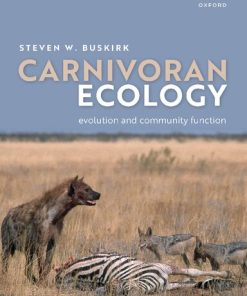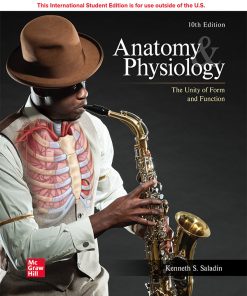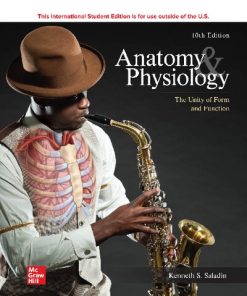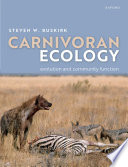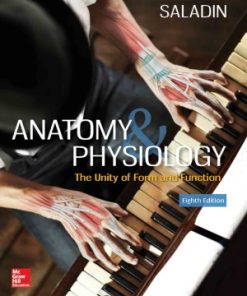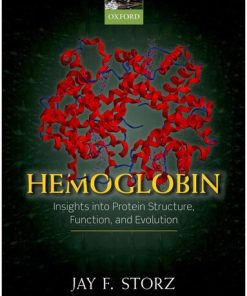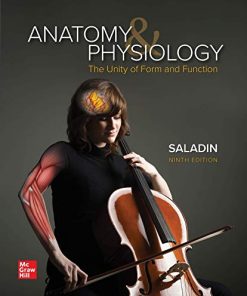Vertebrates comparative anatomy, function, evolution 8th Edition by Kenneth Kardong 1260164169 9781260164169
$50.00 Original price was: $50.00.$25.00Current price is: $25.00.
Vertebrates comparative anatomy, function, evolution 8th Edition by Kenneth V. Kardong – Ebook PDF Instant Download/DeliveryISBN: 1260164169, 9781260164169
Full download Vertebrates comparative anatomy, function, evolution 8th Edition after payment.
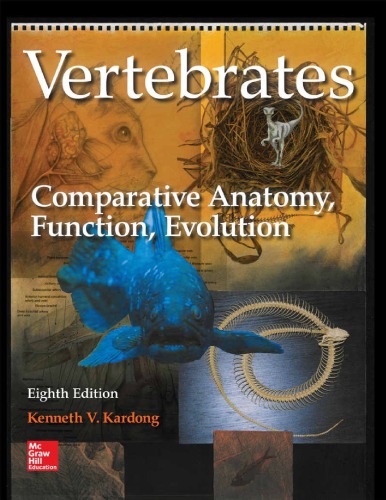
Product details:
ISBN-10 : 1260164169
ISBN-13 : 9781260164169
Author : Kenneth V. Kardong
This one-semester text is designed for an upper-level majors course. Vertebrates features a unique emphasis on function and evolution of vertebrates complete anatomical detail and excellent pedagogy. Vertebrate groups are organized phylogenetically and their systems discussed within such a context. Morphology is foremost but the author has developed and integrated an understanding of function and evolution into the discussion of anatomy of the various systems.
Vertebrates comparative anatomy, function, evolution 8th Table of contents:
Chapter one: Introduction
Comparative Vertebrate Morphology
Designs of Students
Vertebrate Design—Form and Function
Grand Design
Historical Predecessors—Evolution
The Process behind the Change
Linnaeus
Naturalists
J-B. de Lamarck
Acquired Characteristics
Upward to Perfection
Natural Selection
A. R. Wallace
Charles Darwin
Critics and Controversy
Historical Predecessors—Morphology
Georges Cuvier
Richard Owen
Why Are There No Flying Elephants?
Morphological Concepts
Similarities
Symmetry
Segmentation
Evolutionary Morphology
Function and Biological Role
Preadaptation
Evolution as Remodeling
Phylogeny
Of Bean Stalks and Bushes
Simplification
Patterns of Phylogeny
Grades and Clades
Paleontology
Fossilization and Fossils
Recovery and Restoration
From Animal to Fossil
Dating Fossils
Stratigraphy
Index Fossils
Radiometric Dating
Geological Ages
Tools of the Trade
The Question
The Function
The Biological Role
Overview
Chapter two: Origin of Chordates
Chordate Phylogeny
Chordate Characteristics
Notochord
Pharyngeal Slits
Endostyle or Thyroid Gland
Dorsal and Tubular Nerve Cord
Postanal Tail
Chordate Body Plan
Protochordates
General Protochordate Features
Hemichordata
Enteropneusta—“Acorn Worms”
Pterobranchia
Hemichordate Phylogenetic Affinities to Chordates
Hemichordate Phylogenetic Affinities to Echinoderms
Cephalochordata
Urochordata
Ascidiacea—“Sea Squirts”
Larvacea (Appendicularia)
Thaliacea
Overview of Protochordates
Chordate Origins
Chordates from Annelids and Arthropods
Chordates from Echinoderms
Auricularian Hypothesis
Larval Echinoderm to Chordate Tadpole
Chordate Origins and Phylogeny
Dorsoventral Inversion
Overview
Chapter three: The Vertebrate Story
Introduction
Innovations
Vertebral Column
Cranium
Origin of Vertebrates
Step 1: Prevertebrate
Step 2: Agnathan
Step 3: Gnathostome
Vertebrate Classification
Agnathans
Living Agnathans
Myxinoidea
Petromyzontiformes
Early Vertebrate Fossils
Conodonts
Ostracoderms
Pteraspidomorphi
Other Ostracoderms (Osteostracans, Anaspids, Thelodonts)
Overview of Agnathan Evolution
Gnathostomes
Placodermi
Chondrichthyes
Elasmobranchii—Sharks and Rays
Holocephali—Chimaeras
Teleostomi
Acanthodii
Osteichthyes
Actinopterygii
Sarcopterygii
Overview of Fish Phylogeny
Tetrapods
Primitive Tetrapods
Labyrinthodonts
Lissamphibia—Modern Amphibians
Urodela (Caudata)–Salamanders
Salientia (Anura)–Frogs
Gymnophiona (Apoda)–Caecilians
Lepospondyls
Amniotes
Stem-Amniotes
Sauropsids
Reptilia
Synapsida
Pelycosauria
Therapsida
Mammalia
Overview
Chapter four: Biological Design
Introduction: Size and Shape
Size
Relationships Among Length, Area, and Volume
Surface Area
Volume and Mass
Shape
Allometry
Transformation Grids
On the Consequences of Being the Right Size
Biomechanics
Fundamental Principles
Basic Quantities—Length, Time, and Mass
Units
Derived Quantities—Velocity, Acceleration, Force, and Relatives
Reference Systems
Center of Mass
Vectors
Basic Force Laws
Free Bodies and Forces
Torques and Levers
Land and Fluid
Life on Land: Gravity
Life in Fluids
Machines
Strength of Materials
Loads
Biological Design and Biological Failure
Tissue Response to Mechanical Stress
Responsiveness of Bone
Biophysics and Other Physical Processes
Diffusion and Exchange
Pressures and Partial Pressures
Countercurrent, Concurrent, and Crosscurrent Exchange
Optics
Depth Perception
Accommodation
Overview
Chapter five: Life History
Introduction
Early Embryology
Fertilization
Cleavage
Amphioxus
Fishes
Amphibians
Reptiles and Birds
Mammals
Overview of Cleavage
Gastrulation and Neurulation
Amphioxus
Fishes
Amphibians
Reptiles and Birds
Mammals
Organogenesis
Histogenesis
Epithelium
Covering and Lining Epithelium
Glandular Epithelium
Connective Tissues
General Connective Tissues
Special Connective Tissues
Bone Development and Growth
Endochondral Bone Development
Intramembranous Bone Development
Comparative Bone Histology
Bone Remodeling and Repair
Joints
Neural Crest and Ectodermal Placodes
Extraembryonic Membranes
Reptiles and Birds
Mammals
Eutherian Placenta
Other Placentae
Overview of Early Embryonic Development
Development of the Coelom and Its Compartments
Maturation
Metamorphosis
Heterochrony
Peramorphosis
Paedomorphosis
Ontogeny and Phylogeny
Biogenetic Law
Von Baer’s Law
Overview of the Biogenetic Laws
Hox Genes and Their Kingdoms
Egg to Adult
Shaping Up: Positions and Parts
Evolutionary Significance
Epigenomics
Induction
Phylogeny
Overview
Chapter six: Integument
Embryonic Origin
General Features of the Integument
Dermis
Epidermis
Phylogeny
Integument of Fishes
Primitive Fishes
Chondrichthyes
Bony Fishes
Integument of Tetrapods
Amphibians
Reptiles
Birds
Mammals
Specializations of the Integument
Nails, Claws, Hooves
Horns and Antlers
Baleen
Scales
Dermal Armor
Mucus
Color
Overview
Chapter seven: Skeletal System: The Skull
Introduction
Chondrocranium
Embryology
Splanchnocranium
Embryology
Origin of Jaws
Types of Jaw Attachments
Dermatocranium
Parts of the Dermatocranium
Dermal Bone Series
Overview of Skull Morphology
Braincase
Jaws
Hyoid Apparatus
Cranial Kinesis
Phylogeny of the Skull
Agnathans
Early Vertebrates
Ostracoderms
Cyclostomes
Gnathostomes
Fishes
Early Tetrapods
Primitive Amniotes
Modern Reptiles
Birds
Synapsids
Overview of Skull Function and Design
Prey Capture
Feeding in Water
Feeding in Air
Swallowing
Overview
Cranial Neural Crest
Emergence of Mammals
Evolutionary Modifications of Immature Forms: Akinesis in Mammals
Composite Skull
Chapter eight: Skeletal System: The Axial Skeleton
Introduction
Basic Components
Vertebrae
Regions of the Vertebral Column
Centra
Ribs
Sternum
Gastralia
Embryonic Development
Fishes
Tetrapods
Phylogeny
Fishes
Agnathans
Gnathostomes
Tetrapods
Early Tetrapods
Amniotes
Form and Function
Fluid Environment
Terrestrial Environment
Design of Vertebrae
Direction of the Neural Spine
Height of the Neural Spine
Regionalization of the Vertebral Column
Overview
Chapter nine: Skeletal System: The Appendicular Skeleton
Introduction
Basic Components
Fins
Limbs
Origin of Paired Fins
Gill-Arch Theory
Fin-Fold Theory
Embryonic Development of Tetrapod Limbs
Phylogeny
Fishes
Agnathans
Placoderms
Chondrichthyans
Acanthodians
Bony Fishes
Tetrapods
Pectoral Girdle
Pelvic Girdle
Manus and Pes
Evolution of the Appendicular System
Dual Origin of the Pectoral Girdle
Adaptive Advantage of Lobe Fins
Onto the Land
Form and Function
Swimming
Terrestrial Locomotion
Early Gaits
Early Modes of Locomotion
Cursorial Locomotion
Aerial Locomotion
Origin of Bird Flight
Fossorial Locomotion
Overview
Chapter ten: The Muscular System
Introduction
Muscle Anatomy
Classification of Muscles
Skeletal Muscle
Cardiac Muscle
Smooth Muscle
Structure of Skeletal Muscles
Tendons
Basis of Muscle Contraction
Resting and Active Muscle
Molecular Mechanisms of Contraction
Muscle Function
Muscle Fibers
Tension-Length Curves for a Single Muscle Fiber
Properties of Muscle Fibers
Muscle Organs and Fibers
Whole Muscle Force Generation
Tension-Length Curves for a Whole Muscle
Graded Force
Cross-Sectional Area
Fiber Orientation
Velocity of Shortening
Distance of Shortening
Bone–Muscle Lever Systems
Sequencing of Muscle Actions
Overview of Muscle Mechanics
Muscle Actions
Muscle Homologies
Embryonic Origin of Muscles
Muscle Evolution
Postcranial Musculature
Axial Musculature
Appendicular Musculature
Cranial Musculature
Jaw and Pharyngeal Musculature
Branchiomeric Musculature
Extrinsic Eye Muscles
Hypobranchial Musculature
Overview
Chapter eleven: The Respiratory System
Introduction
Respiratory Organs
Gills
Gas Bladders
Lungs
Swim Bladders
Cutaneous Respiratory Organs
Accessory Air-Breathing Organs
Breathing and Embryos
Ventilatory Mechanisms
Cilia
Muscular Mechanisms
Water Ventilation: Dual Pump
Air Ventilation: Buccal Pump
Air Ventilation: Aspiration Pump
Phylogeny
Agnathans
Elasmobranchs
Bony Fishes
Overview of Fish Respiration
Gills
Lungs and Swim Bladders
Amphibians
Amphibian Larvae
Amphibian Adults
Reptiles
Mammals
Ventilation
Gas Exchange
Birds
Form and Function
Patterns of Gas Transfer
Rates of Gas Transfer
Breathing in Water
Breathing in Air
Evolution of Respiratory Organs
Acid-Base Regulation
Ventilation
Ciliary Pumps
Muscular Pumps
Water-to-Land Transition
Air-Breathing Organs
Advantages of Movement to Land
Air-Breathing Mechanisms
Bird Lungs and Air Sacs
Overview
Chapter twelve: The Circulatory System
Introduction
Cardiovascular System
Blood
Arteries, Veins, and Capillaries
Arteries
Hemodynamics of Circulation
Veins
Microcirculation
Single and Double Circulation
Embryonic Development of the Cardiovascular System
Phylogeny of the Cardiovascular System
Arterial Vessels
Venous Vessels
Hearts
Basic Vertebrate Heart
Fishes
Amphibians
Reptiles
Birds and Mammals
Cardiovascular System: Matching Design to Environmental Demands
Accessory Air-Breathing Organs
Diving Birds and Mammals
Heart Flow
Ontogeny of Cardiovascular Function
Fetal Circulation in Placental Mammals
Changes at Birth
Heat Transfer
Lymphatic System
Lymphatic Vessels
Lymphatic Tissue
Form and Function
Overview
Chapter thirteen: The Digestive System
Introduction
Preview
Components of the Digestive System
Buccal Cavity
Boundaries
Palate
Teeth
Tongue
Pharynx
Alimentary Canal
Esophagus
Stomach
Intestines
Cloaca
Specializations of the Alimentary Canal
Vascularization of the Gastrointestinal Tract
Fishes
Tetrapods
Associated Glands of Digestion
Oral Glands
Liver
Pancreas
Function and Evolution of the Digestive System
Absorption
Feces
Mechanical Breakdown of Food
Mastication
Gizzards
Chemical Breakdown of Food
Foregut Fermentation
Hindgut Fermentation
Foregut versus Hindgut Fermenters
Size and Fermentation
Digesting Toxins
Feeding and Fasting
Overview
Chapter fourteen: The Urogenital System
Introduction
Urinary System
Embryonic Development
Nephrotome to Nephric Tubules
Tripartite Concept of Kidney Organization
Kidney Phylogeny
Fishes
Tetrapods
Kidney Function and Structure
Excretion: Removing the Products of Nitrogen Metabolism
Osmoregulation: Regulating Water and Salt Balance
Evolution
Preadaptation
Origin of Vertebrates
Reproductive System
Structure of the Mammalian Reproductive System
Embryonic Development
Gonads and Gametes
Reproductive Tracts
Overview
Female Reproductive System
Ovary
Genital Ducts
Oviduct
Uterus
Male Reproductive System
Testis
Genital Ducts
Copulatory Organs
Cloaca
Urinary Bladder
Function and Evolution
Potency and Fertility
External and Internal Fertilization
Delays in Gestation
Overview
Chapter fifteen: The Endocrine System
Survey of Endocrine Glands
Thyroid Gland
Structure and Phylogeny
Function
Ultimobranchial Body and Parathyroid Gland
Ultimobranchial Body
Parathyroid Gland
Form and Function
Adrenal Gland
Structure and Phylogeny
Function
Pancreatic Islets
Structure and Phylogeny
Function
Pituitary Gland
Structure
Phylogeny
Function
Gonads
Pineal Gland
Secondary Endocrine Glands
Gastrointestinal Tract
Kidneys
Endocrine Coordination
Mammalian Reproduction
Male
Female
Metamorphosis in Frogs
Fundamentals of Hormonal Control
Functional and Structural Linkage
Target Tissue Responses
The Endocrine System and the Environment
Evolution
Overview
Chapter sixteen: The Nervous System
Introduction
Types of Cells within the Nervous System
Neuroglia
Neurons
Transmission of Information
Neurosecretory Cells
Peripheral Nervous System
Spinal Nerves
Cranial Nerves
Evolution
Functions of the Peripheral Nervous System
Spinal Reflexes
The Autonomic Nervous System
Central Nervous System
Embryology
Spinal Cord
Spinal Reflexes
Spinal Tracts
Brain
Phylogeny
Form and Function
Functional Associations of Parts of the Central Nervous System
Limbic System
Overview
Chapter seventeen: Sensory Organs
Introduction
Components of a Sensory Organ
General Sensory Organs
Free Sensory Receptors
Encapsulated Sensory Receptors
Associated Sensory Receptors
Proprioception
Mechanisms of Perceiving Stimuli from General Sensory Receptors
Special Sensory Organs
Chemoreceptors
Nasal Passages
Vomeronasal Area
Mouth
Radiation Receptors
Photoreceptors
Infrared Receptors
Mechanoreceptors
Lateral Line System
Vestibular Apparatus
Auditory System
Functions of the Ear
Electroreceptors
Structure and Phylogeny
Form and Function
Additional Special Sensory Organs
Overview
Chapter eighteen: Conclusions
Introduction
Approaches—Structure, Function, Environment (Ecology)
The Here and Now
Structural Analysis
Functional Analysis
How Does It Work?
Functional Coupling, Functional Compromise
Multiple Functions
Performance
Ecological Analysis
Evolutionary Analysis
Historical Constraints
Primitive and Advanced
Diversity of Type/Unity of Pattern
Mosaic Evolution
Morphology and Modules
Mode and Tempo of Evolution
Remodeling
Embryonic Changes
Hox Genes
People also search for Vertebrates comparative anatomy, function, evolution 8th:
borrow vertebrates comparative anatomy function evolution
ise vertebrates comparative anatomy function evolution
vertebrates comparative anatomy function evolution by kenneth kardong
vertebrates comparative anatomy function
vertebrates comparative anatomy pdf
Tags: Vertebrates, comparative anatomy, function, evolution, Kenneth Kardong
You may also like…
Biology and other natural sciences - Ecology
Carnivoran Ecology : The Evolution and Function of Communities Steven W. Buskirk
Medicine - Anatomy and physiology
Anatomy and Physiology: The Unity of Form and Function ISE 10th Edition Kenneth Saladin
Uncategorized
Medicine - Anatomy and physiology
Biology and other natural sciences
Carnivoran Ecology: The Evolution and Function of Communities Steven W. Buskirk
Medicine - Anatomy and physiology
Anatomy & Physiology. The Unity of Form and Function 8th Edition
Medicine - Anatomy and physiology
Essentials of Anatomy & Physiology, 2nd Edition Kenneth S. Saladin
Science (General)
Science
Anatomy & Physiology: The Unity of Form and Function (loq quality) 9th Edition Kenneth Saladin



